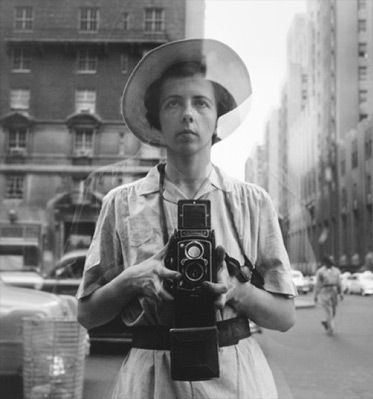
| HOME |
| NERVE |
| REVIEWS |
| ARCHIVE |
| EVENTS |
| LINKS |
| ABOUT US |
| CONTRIBUTORS |
| BACK ISSUES |
| CONTACT US |
Finding Vivian Maier
 Picturehouse,
Liverpool
Picturehouse,
Liverpool
18th July - 31st July 2014
Reviewed by Colin Serjent
This film about the enigmatic and highly talented photographer Vivian Maier is a perfect companion piece to the fascinating Imagine documentary, titled Who Took Nanny's Pictures (a cringe inducing title), presented by Alan Yentob, on BBC1 last year.
In that programme Yentob quoted Van Gogh, who said that "stars were the souls of dead poets, but to become a star, you had to die."
This is an apt quote in regard to Maier. Since the discovery of her massive treasure trove of negatives, numbering up to 150,000, the vultures quickly gathered to exploit her legacy, after she had died in 2009. Virtually unknown as a photographer when she was alive her work now sells for four figures numbers. Who is pocketing the money from these sales?
The source of the discovery of her work was John Maloof, an estate agent, who was seeking historical images of Chicago that he could use in a book, bought over a hundred boxes of her negatives at a Chicago auction house in the city, as well as undeveloped rolls of film, Super 8 home movie footage (recording children playing, who were under her charge in her job as a nanny for a period of forty years with different families in Chicago) audio tapes and trunks full of memorabilia.
The reason for all these items being auctioned - she was still alive at the time - was that Maier was unable to keep up payments on a storage locker, where she had kept them.
Oddly enough Maloof found a number of tax refund cheque payments, to the value of thousands of dollars, sent to her by the American equivalent of the Inland Revenue, which she had failed to cash in. This was one of many unusual traits she displayed throughout her life.
When Maloof started to scan and print some of her photographs, he knew straight away that he had discovered one of the great names of 20th-century American photography, to rank alongside Robert Frank, Diane Arbus and Dorothea Lange.
Using a Rolleiflex camera, her major preoccupation in her photography, primarily in the 1950s and 1960s, was in depicting street scenes in Chicago and New York, taking heartfelt images of people on the fringes of American society - the poor, the dispossessed, the old, children and black people.
The film includes interviews with some of the now grown up children Maier looked after, with many of them contradicting one another with their memories of the personality of their former nanny. Some found her caring and loving, to others she was intolerant and stern. I did not pay much heed to any of their opinions.
They all pigeon-holed her like so many people do when assessing other people. What mattered to me in the film was the immense talent she possessed as a photographer.
NERVE supports workers struggling for a living wage. For more information see: liverpooliww.wordpress.com/2014/05/02/big-turnout-for-may-day-picket-at-fact